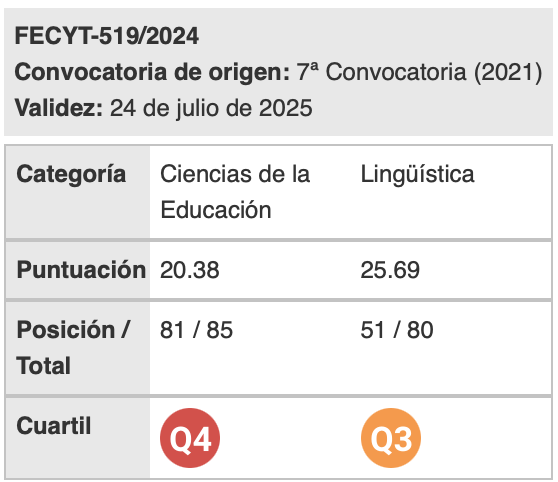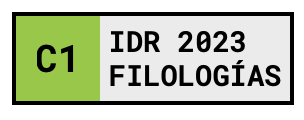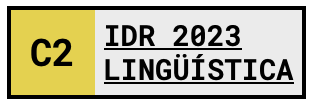Overlapping of ESP/EAP and content courses revisited
Keywords:
ESP/EAP courses vs. content courses, ESP practitioners, effective technical communicationAbstract
This paper deals with some key issues in a controversial topic, that of the existing overlapping between ESP/EAP courses and simultaneously-run content courses. Some examples are provided and analyzed to be aware of the need of ESP/EAP practitioners to have a fairly deep knowledge of those technical matters they have to deal with in order to be as genuinely communicative as possible. later on, a list of principles for designing successful ESP/EAP courses is presented and justified. After putting into practice a communicative approach founded on those principles for a period of five years, the opinion of those students who have taken two ESP/EAP courses was gathered –an ad hoc questionnaire was developed for the purpose–. data are analyzed to hypothesize the long-run correlation between applying the above mentioned principles and the positive opinion of students on their teachers when those principles are applied at university level.
Downloads
References
Belcher, D. D. (2004). Trends in teaching English for specific purposes. Annual
Review of Applied Linguistic, 2, 165-186.
Berardo, S. A. (2006). The use of authentic materials in the teaching of reading.
The Reading Matrix, 6(2), 60-69.
Brewster, J. (1999). Teaching English through Content: Supporting Good Practice.
in C. Kennedy (Ed.), Innovation and Best Practice (83-95). New York, NY: longman. Crandall, J. (1998). Collaborate and Cooperate: Teacher Education for integrating
language and Content instruction. FORUM, 36(1), 2.
Crossley, S. A., Louwerse, M. M., McCarthy, P. M. and McNamara, D. S.
(2007). A linguistic analysis of simplified and authentic texts. The Modern Language Journal, 91(1), 15-30.
Dudley-Evans, T. and St John, M. J. (1998). Developments in English for Specific Purposes. A multi-disciplinary approach. Cambridge: Cambridge University Press.
Dudley-Evans, T. (2001). English for Specific Purposes. in R. Carter & d. Nunan (Eds.), The Cambridge Guide to Teaching English to Speakers of other Languages (131-136). Cambridge: Cambridge University Press.
Gilmore, A. (2004). A comparison of textbook and authentic interactions. ELT Journal, 58(4), 363-374.
Haley, M. H. and Austin, T. Y. (2004). Content-based second language teaching and learning. Boston, MA: Pearson education.
Harding, K. (2007). English for specific purposes. Oxford: Oxford University Press. Horwitz, E. K. (2008). Becoming a language teacher: a practical guide to second language
learning and teaching. Boston, MA: Pearson Education.
Jordan, R. R. (1997). English for Academic Purposes. A guide and resource book for
teachers. Cambridge: Cambridge University Press.
Kasper, L. F. (1997). The impact of content-based instructional programs on the academic progress of ESl students. English for Specific Purposes, 16(4), 309-320.
Kavaliauskiene, G. (2004). Research into the integration of content-based instruction into the ESP classroom. Journal of Language and Learning, 2(1), 1-12.
MacDonald, M. N., Badger, R. and Dasli, M. (2006). Authenticity, culture and language learning. Language and Intercultural Communication, 6, 1-12.
Mishan, F. (2005). Designing Authenticity into Language Learning Materials. Bristol: intellect.
Mitchell, R. and Myles, F. (2004). Second language learning theories (2nd ed.). london: Hodder Arnold.
Parkinson, J., Jackson, L., Kirkwood, T. and Padayachee, V. (2007). A scaffolded reading and writing course for foundation level science students. English for Specific Purposes, 26(4), 443-461.
Radu, M. E. and Nicoara, S. (2006). Offering Engineering degrees in a Foreign language – Preparing Engineers for a Global Experience. 9th International Conference on Engineering Education. San Juan, Puerto Rico, http://www.ineer.org/ Events/iCEE2006/papers/3434.pdf accessed April 10, 2012.
Shulman, L. (1987). Knowledge and teaching: Foundations of the new reform. Harvard Educational Review 57(1), 1-22.
Song, B. (2006). Content-based ESl instruction: long-term effects and outcomes. English for Specific Purposes, 25(4), 420-437.
Widdoson, H. G. (1993). Proper Words in Proper Places. ELT Journal, 47(4), 317-329.
Wu, H. and Badger, R. G. (2009). in a strange and uncharted land: ESP teachers’ strategies for dealing with unpredicted problems in subject knowledge during class. English for Specific Purposes, 28(1), 19-32.
Downloads
Published
How to Cite
Issue
Section
License
Authors who publish with this journal agree to the following terms:
- Authors retain copyright and grant the journal right of first publication with the work simultaneously licensed under a Creative Commons Attribution License that allows others to share the work with an acknowledgement of the work's authorship and initial publication in this journal.
- Authors are able to enter into separate, additional contractual arrangements for the non-exclusive distribution of the journal's published version of the work (e.g., post it to an institutional repository or publish it in a book), with an acknowledgement of its initial publication in this journal.
- Authors are permitted and encouraged to post their work online (e.g., in institutional repositories or on their website) prior to and during the submission process, as it can lead to productive exchanges, as well as earlier and greater citation of published work (See The Effect of Open Access).

Revista de Lenguas para fines específicos is licensed under a Creative Commons Reconocimiento-NoComercial-SinObraDerivada 4.0 Internacional License.
























